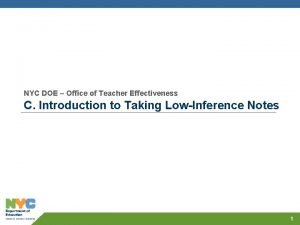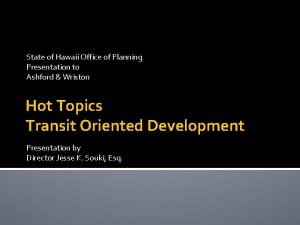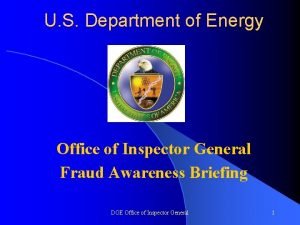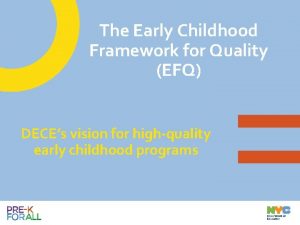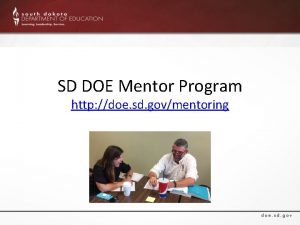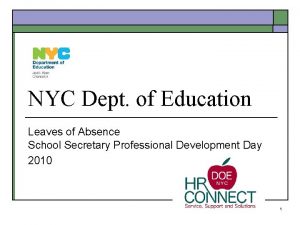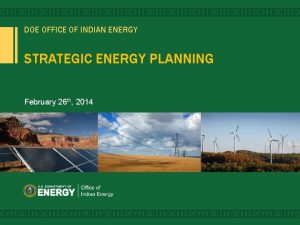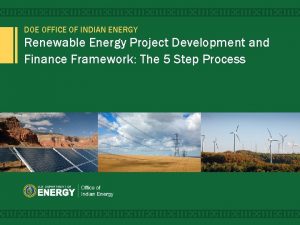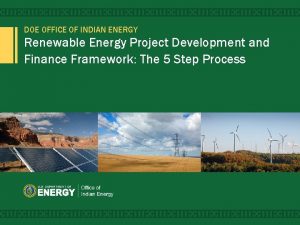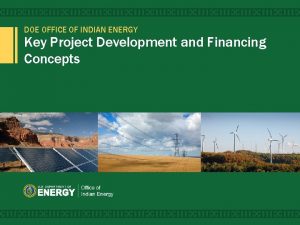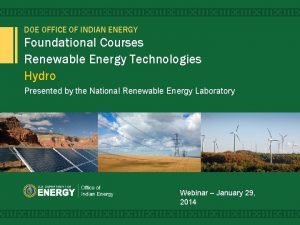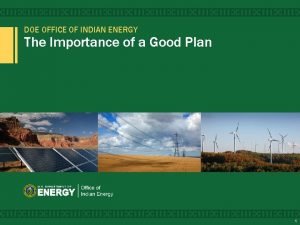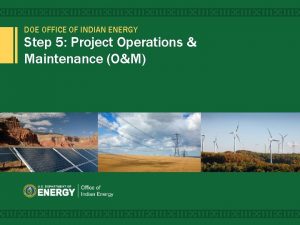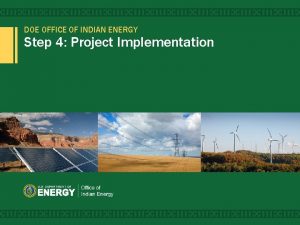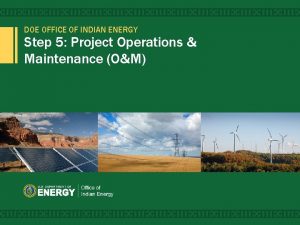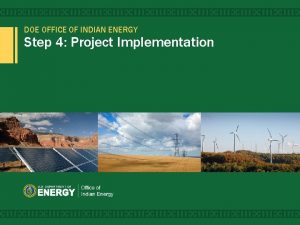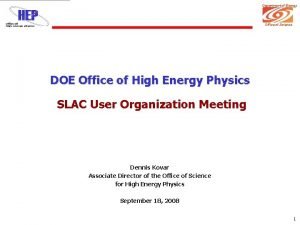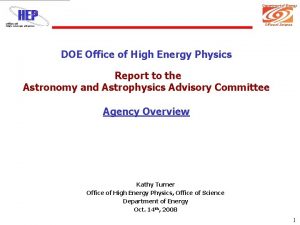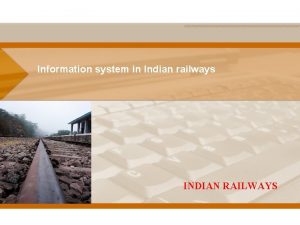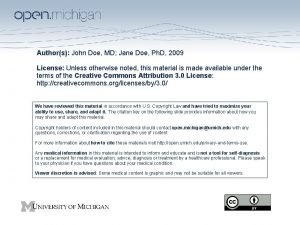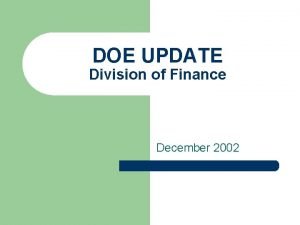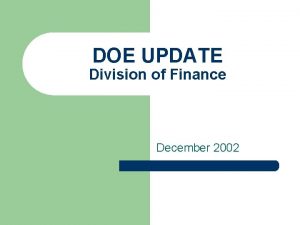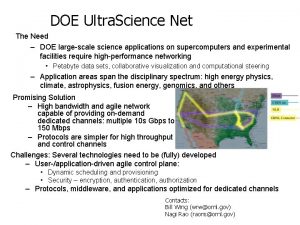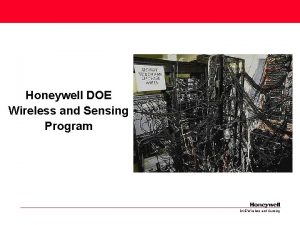DOE OFFICE OF INDIAN ENERGY Energy Planning Agenda























- Slides: 23

DOE OFFICE OF INDIAN ENERGY Energy Planning

Agenda • • What is energy planning? The process The plan Strategic Energy Planning (SEP) Workbook • Other resources 2

What is Energy Planning? The plan should be “Strategic” by applying Strategic Energy Planning (SEP) principles. vs. • Brings desired clean energy future into clear focus (Empowering) • Considers current reality (Baseline, Data-Driven) and leverages local resources • Considers hurdles/challenges before you reach them (Inclusive) • Maps out a more efficient path to achieve your desired energy future • Clarifies progress indicators (Measurement and Verification) • Documents the game plan for short- and long-term success Graphic concepts reprinted with permission from Lesley Kabotie, Indigenous Collaboration, Inc. . 3

What Makes Energy Planning “Strategic”? Inclusive Energy Planning Process Public Sector (tribal/state/federal) Nonprofit Stakeholder buy-in to long-term … vision Political commitment to mobilize authority and resources … Identify energy uses and future needs (baseline) Private Sector Graphic concepts reprinted with permission from Lesley Kabotie, Indigenous Collaboration, Inc. . 4

Strategic Energy Planning: Leadership Team vs. Not just people with the “right” idea, but those committed to the long-term task with personal and political influence. Include Avoid • Individuals with authority to direct resources • Exclusively political appointees • Individuals with a passion for the “destination” • Exclusively technical staff • Exclusively implementers • Individuals with influence in the community and administrative abilities to keep the project alive • Individuals with the technical ability • Individuals who can “tell the story” Graphic concepts reprinted with permission from Lesley Kabotie, Indigenous Collaboration, Inc. . 5

Planning is Coordinated and Collective Action Community Technical Staff Partners Leadership Staff Tribal Leadership Proper planning and strategic energy plan development helps stakeholders: • Direct action • Sustain momentum • Motivate involvement • Reduce/minimize reactive decision-making • Go the distance. Graphic concepts reprinted with permission from Lesley Kabotie, Indigenous Collaboration, Inc. . 6

Why Does Strategic Energy Planning Fail? • Short-sighted predictions of the situation, timeline • Unrealistic predictions of resources • Uncoordinated implementation • Narrow ownership • Failure to follow the plan • Poor, or casual, communication. Graphic concepts reprinted with permission from Lesley Kabotie, Indigenous Collaboration, Inc. . 7

Steps in Strategic Energy Planning Identify/Convene Stakeholders Measurement & Verification (M&V) and Plan Alterations Compile Energy Plan Identify Financing Options Prioritize Projects & Programs Form Leadership Team Develop Energy Vision Assess Energy Needs & Resources Develop Specific Goals 8

Strategic Energy Planning: First Steps Identify/Convene Stakeholders Form Leadership Team Develop Energy Vision 9

First Steps: Identify and Convene Stakeholders • • Tribal members Tribal council Tribal government Tribal utilities • Tribal enterprises • Large energy users • Local utilities Key success component: Identify and select an energy “champion” to shepherd the process Photo by Karen Petersen, NREL 10

First Steps: Form a Leadership Team Draw from the stakeholders: • Tribal council member(s) • Tribal government executives • Tribal member representative(s) • Tribal enterprise leader(s) Photo by Dennis Schroder, NREL 11

First Steps: Develop an Energy Vision Common objectives include: • Increase and ensure energy reliability • Minimize environmental impacts • Diversify energy supply • Use local, renewable resources • Strengthen, support economic development • Build workforce/jobs Energy Vision Example: Forest County Potawatomi, WI “Ultimately reduce the tribe's carbon footprint to zero while leading energy strategy initiatives, which support and promote the efforts of others working to reduce their own carbon footprints. ” DOE-IE Foundational Strategic Energy Planning • Ensure energy affordability • Generate revenue for tribe • Energy security/self-sufficiency • Off-grid electrification • Save money (offset energy costs) • Keep money in tribe • Stabilize energy costs for tribe and tribal members. The Forest County Potawatomi Tribe’s 30 -k. W solar PV system on the roof of its administration building in Milwaukee, WI. Photo from the Forest County Potawatomi Tribe, NREL 20107. 12

Strategic Energy Planning: Priorities & Decisions Identify Financing Options Prioritize Projects & Programs Assess Energy Needs & Resources Develop Specific Goals 13

Priorities & Decisions: Assess Energy Needs Document the community baseline: • Determine energy use by “sector” including government, residential, school, and commercial • Use available tools: – Energy audits – EPA Portfolio Manager (non-residential buildings) • Forecast future load – New housing – New government facilities – New/expanded enterprises Photo by Alex Dane, NREL 22724 • Verify current service providers and rates for electricity, gas, propane, wood, and others. 14

Priorities & Decisions: Develop Specific Goals Examples: • Reduce electricity use by ___% by 2022 • Obtain ___% of electricity from renewable sources within 10 years (similar to a renewable portfolio standard or RPS) • Reduce energy costs by ___% within 5 years Photo by Karen Petersen, NREL 15

Priorities & Decisions: Prioritize Projects & Programs • Develop a ranking system to understand cost-effectiveness of different projects • Best practice models: – Total resource cost • Model considers life-cycle benefits for projects – Levelized cost of energy • Allows comparison across different technologies • Tribal energy policy/program examples: – Incentives to reduce energy use – Incentives to promote renewable energy – Sustainable/green building codes, standards, or other requirements or guidelines. Photo by Bob Gough, NREL 15954 16

Priorities & Decisions: Identify Financing Options Secure planning and project funding sources: • Tribal funding (energy. gov/indianenergy/fedprogram s) • Database of State Incentives for Renewables & Efficiency (http: //www. dsireusa. org/) • DOE Technical Assistance (TA) Program (http: //www. energy. gov/indianenergy/r esources/technical-assistance) • Other federal agency TA and grant programs • State programs • Non-governmental organizations (NGOs) Photo by Alex Dane, NREL 17

Strategic Energy Planning: Energy Plan M&V and Plan Alterations Compile Energy Plan 18

Energy Plan: Purpose and Functions Purpose: Functions: • Document near-term goals • Creates “road map” to hold accountability to the destination • Sustain momentum • Achieve long-term goals • Provides the means to consistently share the story with others • Creates resources to help guide and filter priorities, providers, and decisions 19

Energy Plan: Components Include: • Vision • Objectives • Goals • Baseline • Barriers • Program/project options – Demand side – Generation • Recommendations • Adoption by Tribal Council Photo by Paul Dearhouse, NREL 24503 20

Strategic Energy Planning Handbook for Lower 48 Tribes and Alaskan Native Villages http: //www. energy. gov/indianenergy/dow nloads/alaska-strategic-energy-plan-andplanning-handbook http: //www. energy. gov/indianenergy/dow nloads/tribal-strategic-energy-plan-andplanning-handbook 21

Other Resources to Consider • Community Greening: How to Develop a Strategic Energy Plan (SEP). This paper provides a succinct overview of each step in the strategic energy planning process for local jurisdictions. http: //www. nrel. gov/tech_deployment/pdfs/community_greenin g. pdf • Community Energy Strategic Planning. This guide provides a more thorough review of the energy planning process. http: //energy. gov/sites/prod/files/2014/05/f 15/cesp_guide. pdf • U. S. DOE Energy Efficiency and Renewable Energy Office SEP Resources. This website provides tools and tips for each step in the SEP process and there are case studies available examining other cities experiences with the SEP process. http: //energy. gov/eere/slsc/guide-community-energy-strategicplanning 22

On-Request Technical Assistance Apply for up to 40 hours of in-depth technical assistance to: • Address a specific challenge • Fulfill a need that is essential to a current project’s successful implementation. Two categories of technical assistance: 1. Strategic Energy Planning—An on-site workshop that walks tribal leaders and staff through a nine-step planning process 2. Project Development Support—Expert guidance and analysis that helps address specific project barriers. Examples include: o Third-party independent reviews of transmission studies, financing structures, lease agreements, project reports o Modeling and analysis (or assistance using modeling/analysis tools) o Pre-feasibility transmission studies o Interconnection agreement facilitation o Economic evaluations o System design reviews. Learn more and apply online: energy. gov/indianenergy/technicalassistance 23
 Nyc doe office 365
Nyc doe office 365 Agenda sistemica y agenda institucional
Agenda sistemica y agenda institucional Office in factory
Office in factory Hawaii office of planning
Hawaii office of planning Energy energy transfer and general energy analysis
Energy energy transfer and general energy analysis Energy energy transfer and general energy analysis
Energy energy transfer and general energy analysis Strategic planning vs tactical planning
Strategic planning vs tactical planning Planning balance sheet in urban planning
Planning balance sheet in urban planning Scenario planning workforce planning
Scenario planning workforce planning Inactivism planning
Inactivism planning Perencanaan kapasitas dan agregat
Perencanaan kapasitas dan agregat Short term planning and long term planning
Short term planning and long term planning Language planning and policy slideshare
Language planning and policy slideshare Aggregate planning is capacity planning for
Aggregate planning is capacity planning for Examples of aggregate planning
Examples of aggregate planning Doe inspector general
Doe inspector general Efqq
Efqq Sd doe mentor program
Sd doe mentor program Serp.doe.louisiana login
Serp.doe.louisiana login Modified promotion criteria nyc doe
Modified promotion criteria nyc doe Uft sabbatical
Uft sabbatical Homophone hunt answer key
Homophone hunt answer key Jane doe john smith
Jane doe john smith Doe order 420
Doe order 420
